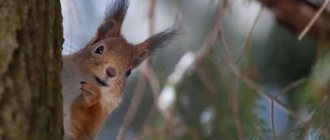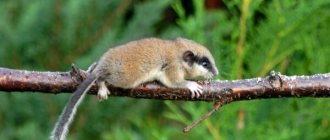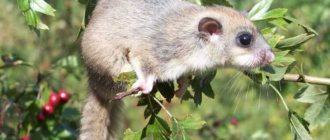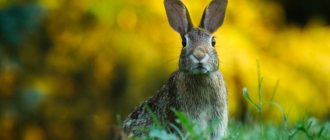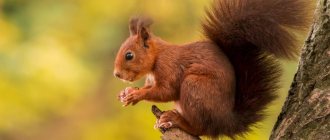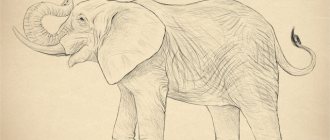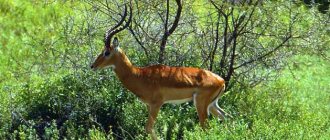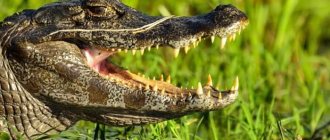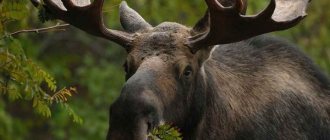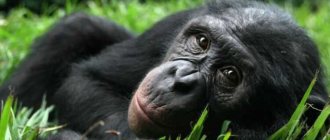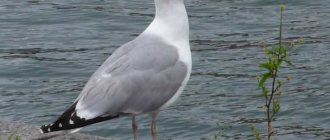Characteristics and description of the animal
Squirrels live alone and gather in groups only during migrations or severe frosts. Under favorable conditions, the animals remain within the same territory, but they are not characterized by clear demarcation of areas and clashes with relatives who violate the boundaries.
Squirrels can change their habitat in case of food shortage, moving over distances of 50 to 200 km. At the end of summer and beginning of autumn, seasonal migration of young animals occurs: grown-up squirrels leave the parental nest and go in search of their own territory.
Squirrels lead a predominantly arboreal lifestyle and descend to the ground only for a short time. The crown of trees hides them from predators and provides them with food.
Squirrels not only climb deftly and jump from branch to branch, but also swim well. If necessary, they can cross wide rivers and lakes. When plunging into the water, the animal lifts its tail up and swims. If for some reason the long, bushy tail gets wet, the squirrel may drown.
What does a squirrel look like?
Golden-bellied
The external structure of the animal has the following features:
- the body is thin, elongated;
- the hind legs are longer and have more developed muscles; the toes have sharp claws;
- the head is rounded with a muzzle slightly extended forward, the ears are long, in some species they end in a tassel;
- The squirrel's tail is completely covered with hair, its length is usually 2/3 of the length of the animal's body.
The color of the squirrel depends on the variety, habitat and season. Albinos and melanists occasionally appear in female common squirrels.
Squirrel fur
Western gray
The growth density of hairs on the body of a squirrel is 7-9 thousand per 1 square meter. cm. The length of the guard hairs is 2-2.5 cm, the underhairs are 2 times shorter.
The squirrel has long been considered a fur-bearing animal. Large-scale production of rodent skins began in the 18th century and lasted until the middle of the last century, after which the fishery began to decline.
Squirrel fur belongs to the fur of the middle price category. It is light, soft and quite thick, but not very warm and quickly loses its appeal. Most often, squirrel is used for decorative finishing of products. The highest quality skins are those obtained after the end of the autumn molt.
How many years do they live
The lifespan of a squirrel largely depends on living conditions. Individuals living in nature live only up to 4-5 years. The premature death of animals is usually associated with attacks by enemies or lack of food during the winter months.
Animals kept at home often reach the age of 10-12 years. The record documented lifespan of a squirrel was 23.5 years. The longest-living species was the captive Carolina squirrel.
ELK
What does a squirrel eat?
The diet of this animal directly depends on its habitat and species. Most squirrels prefer nuts, seeds of coniferous trees, acorns, and do not refuse mushrooms and fruits of wild plants. If there are fields near the forest, rodents will definitely feed on grains. In times of hunger, they can eat plant buds or young shoots.
The animals make provisions for the cold season. They arrange their storerooms in nests, hollows, or hang them on branches. Sometimes the forest squirrel buries its supplies, which greatly helps plant seeds to germinate.
In the tropical forests where the squirrel lives, the animal's diet may include tree fruits and flower nectar.
But these animals cannot be called completely herbivorous. Many of them eat insects and invertebrates, thereby replenishing the body’s supply of proteins. Squirrel tracks are often found near water bodies, where rodents sometimes even hunt frogs and lizards.
If you hand feed squirrels, it is better not to give them flour products and sweets. They are of little use, but they can cause harm to the animal.
Females feed their young with milk, so the question: “Is a squirrel a mammal or not?” disappears by itself.
Types of squirrels: photos with names
Let's look at several varieties of squirrels in more detail.
Ordinary
The only species widespread in Russia. The common squirrel, or Veksha, has 16 subspecies, the division into which is mainly based on territorial characteristics (Altai, Sakhalin, Bashkir, Siberian, etc.).
The common squirrel is characterized by seasonal molting: before the onset of cold weather, the body of the animal is covered with fluffy and long fur, while gray and black colors predominate in color; in the spring, tougher and shorter fur of brown, red or brown shades grows.
Caucasian
Distributed in the Caucasian Isthmus, as well as in the countries of the Middle East. In some sources the species is also called the Persian squirrel. The animals prefer deciduous forests with a sufficient amount of oak, chestnut and walnut. Adults can live alone or in pairs.
Caucasian squirrels have no commercial value due to the hardness of their fur.
Motley
The species received its name for its bright contrasting color: the animal’s belly is yellow-gray or white, its paws and sides are red-brown or red, its back is almost black, and the dark hairs located on its tail have gray tips.
The spotted squirrel is common in Central America. The basis of the animal’s diet is the pulp of the fruit.
Ratufa
Also known as the Indian giant squirrel. It is found in deciduous, mixed and evergreen forests of India. Ratufs form a large number of local populations isolated from each other. Each group differs in the color scheme of the coat (cream predominates, various shades of yellow and brown), as well as in the size and location of spots on the body. The Malabar squirrel, one of the subspecies of ratufa, has the most striking appearance.
Indian squirrels spend almost their entire lives on the upper tier of trees and very rarely descend to the ground. They move around the territory by jumping from branch to branch, covering a distance of up to 6 m in a jump.
Red-tailed
One of the most numerous American species of squirrels. Distinctive features of the species are a curved skull with a more elongated muzzle and a bright red tail color.
Red-tailed squirrels are found in South and Central America. The highest habitat density of these mammals is observed in forests near water bodies.
Palm
It lives in the tropical forests of Hindustan and on the island of Ceylon. One of the smallest representatives of the family: the weight of adults does not exceed 100 grams. You can identify a palm squirrel by the presence of three light stripes running along the back from head to tail.
Rodents are known to move towards farmland and cause damage to coffee plantations if there is not enough food in their habitat.
BAT
Description and features
The squirrel is a cute, small animal from the order of rodents, with a slender body and elongated, strong legs. Typically, such animals do not weigh more than a kilogram and are 40 cm long, but they can be one and a half to two times smaller, depending on the species.
However, in the vast family of squirrels there are larger representatives. These are animals from the genus of giant squirrels, growing in length up to 50 cm or more, reaching a weight of 3 kg. But in this animal community there are also tiny ones - representatives of the genus of dwarf squirrels, no more than 7.5 cm tall.
A distinctive feature of the appearance of such creatures is a slightly elongated, small head, on which there are black shiny button eyes and a neat rounded nose, as well as long, elongated, erect ears ending in funny tassels, especially noticeable in winter.
The squirrel's forelimbs with movable five fingers resemble hands. They are shorter than the rear ones. And, leaning on their legs, these animals are able to skillfully wield them, performing rather delicate operations that are useful in everyday life.
But the most remarkable detail of its appearance is the squirrel's tail . This fluffy and very noticeable part of the body, which in a calm state borders the back of the animal from bottom to top and is two-thirds the size of these creatures themselves, helps them move.
It functions as a steering wheel, stabilizing the position of the body and regulating the direction of movement. The described representatives of the animal kingdom spend a huge part of their lives in trees, high above the surface of the earth. They have cleverly adapted to climb branches and trunks, clinging to them with their sharp claws.
Delighting an outside observer, they write out intricate complex trajectories with grace and at the same time, when moving, they seem almost weightless. Their masterly jumps are sometimes up to four meters long. And therefore, not only when moving, but also when suddenly falling, squirrels find their tails very useful, with which they skillfully maneuver.
When danger approaches and in tragic situations, these animals produce piercing sounds, which serves as a signal for their fellow creatures, forcing them to remain on their guard.
Their vision and hearing are excellently developed. Additional devices for the sense of touch are vibrissae - hard hairs that stand out above the main coat, located on the muzzle, front legs and tummy.
Fluffy, especially in winter, squirrel fur is lightweight. Moreover, the richness of its color is manifested not only in the species diversity of such creatures, but also in seasonal changes. In summer, most often the main background of their cover is red, brown or brown.
There are melanistic black squirrels and, in contrast, albinos. In winter, their fur changes from short and stiff to thicker, softer and longer, the color tones become gray, and the belly of the animals becomes lighter. These are very cute creatures, but their characteristics can best be judged by looking at the squirrel in the photo .
Dimensions
Below is information about the weight and size of some varieties of squirrels.
| Variety | Weight, g | Body length, cm | Tail length, cm |
| Western gray | 942 | 50 | 30 |
| Goldenbellied | 505 | 25,8 | 25,5 |
| Allen's squirrel | 470 | 26,7 | 20,8 |
| Persian | 430 | 25,5 | 17 |
| Växa | 340 | 28 | 19 |
| Japanese | 250 | 22 | 17 |
| Guiana | 180 | 20 | 18,3 |
Common squirrel
The most popular variety of the squirrel family. Habitat: Eurasian territory from Ireland to Japan.
In addition, the squirrel is not afraid to live close to people. We can see this while walking through a forest or park area. Fur color is red.
Where do they live?
The habitat of squirrels covers all continents with the exception of Australia and Antarctica. Most species are common in taiga, deciduous and mixed forests. Squirrels are also found in such natural areas as tropical rainforests, evergreen subtropical forests, monsoon forests
Where live
Suitable habitat for squirrels is dense lowland forests and ribbon forests with a sufficient number of tall trees, as well as old trees with hollows. Some species (Santander squirrel, Deppe squirrel, red-tailed squirrel) are able to live in mountain forests located at an altitude of 2-4 thousand meters above sea level.
Where do squirrels live?
These funny animals have spread over many continents, with the exception of the desert regions of Africa, the polar regions of Eurasia, and Antarctica.
Squirrels are animals that live exclusively in trees: here they make shelters for themselves, breed their offspring, and find food, so in the places where the squirrel lives there must be tall vegetation. These can be coniferous, mixed and even tropical forests. The main thing is to have the opportunity to make a shelter for yourself.
In search of food, squirrels quite often come to cities, especially those located near forests.
These animals also feel great in city parks, where, without any fear, they take food from people’s hands. But it is very difficult to catch them - the animal reacts so sensitively to every movement that at the slightest danger it instantly hides in the crown of a tree.
Squirrels build shelter houses for themselves. Depending on the species, these can be nests made of branches, spherical or resembling bird nests; other squirrels prefer to live in a hollow, naturally formed or hollowed out by birds. Most often, an animal has several houses that serve different purposes. Somewhere she hides supplies, somewhere she breeds. The animal keeps the hollow clean, constantly throwing out garbage and feces, so you can find out which tree the animal lives on by looking at the piles of garbage on the ground.
Usually a squirrel in its hollow or nest lines the bottom with branches, moss, and feathers to make it warm and cozy. Before the cubs appear, she arranges a special place, adding her own fluff to it.
What do they eat
Allen's squirrel
The basis of the squirrel's diet is coniferous tree cones, acorns, and nuts. The animals also eat berries, mushrooms, seeds of herbs and shrubs, and lichens. In early spring, when the stored reserves are completely eaten, squirrels feed on buds and young shoots, and can dig up roots and tubers from the ground.
In tropical species, the diet is dominated by animal food: larvae and adult insects, bird eggs, small amphibians and reptiles. Squirrels living in temperate latitudes, mainly females, also partially switch to animal food. This way they get more nutrients to recover after the birth of their babies.
FLYING SQUIRREL
Nutritional Features
The squirrel can be considered an omnivorous rodent; it can use for food:
- seeds from coniferous trees (spruce, pine, cedar, fir);
- hazel, acorns, nuts;
- mushrooms;
- buds of young plants;
- berries;
- plant roots;
- lichen;
- herbs.
If the year is lean, then most of their diet consists of grasses and roots. During the mating season, squirrels prefer to eat animal food: insects, larvae, eggs of small birds, small vertebrates. In early spring, they can gnaw on the bones of dead animals.
For the winter, they prefer to make supplies, which are stored in hollows, rhizomes, or simply hung on trees with dense branches. Such products include: nuts, mushrooms, pine cones, acorns. They do not remember about their reserves and often find them by accident. Squirrels can feed on the supplies of other animals.
How do they reproduce?
Sexual maturity in squirrels occurs at the age of 9-10 months. Rodents living in colder climates produce one litter per year; among inhabitants of the southern regions, the number of litters can reach three.
During the breeding season, the female chooses one of several suitors. At this time, fights may occur among animals that have a fairly peaceful character. It is believed that individuals with bushy tails have a greater chance of mating. Before the cubs appear, the female is engaged in arranging several nests. The male does not take part in preparing for the appearance of offspring and raising them.
Squirrels are born 35-40 days after fertilization. In the first litter the number of cubs can reach 6-8, in subsequent litters there are fewer of them. Baby squirrels are born without hair and with their eyes closed. Babies acquire fur by the age of two weeks, and begin to see only when they are a month old.
The female continues to feed the squirrels with milk for up to 8 weeks, after which the stronger and older cubs are able to get their own food. 3 months after the first rut, the female is again ready for fertilization.
Reproduction and lifespan
Wild squirrels are quite capable of producing offspring up to three times per season. But usually this happens twice, then they bear offspring in April, and then only in June. For the first time, the signal for the start of a new breeding cycle is the awakening of nature. This happens when winter is receding, and spring is just beginning to come into its own, the snow has not yet melted, but the sun is warming up more strongly, and the days are becoming much longer.
During the period of preparation for mating, representatives of the male half show noticeable aggressive activity. Males attack competitors and start desperate fights among themselves, competing for a partner, the number of contenders for which sometimes reaches up to six males. However, in the end, only one of the competitors, usually the strongest, receives the honorary right to leave offspring.
Only the mother squirrel is responsible for building the nest for the new generation, and she begins this important task immediately after mating is completed. In the future, she will take care of the brood without the participation and help of the partner, who has already done everything that nature required of him.
A squirrel nest is almost an ordinary hollow, only somewhat larger in size. At the end of the gestation period, which lasts up to forty days for the female, birth occurs, and naked, deaf and blind squirrels are born in an amount of up to ten tiny individuals.
During the first hours and days of their lives, they huddle close to their mother from the cold, warming themselves from her body. And only after two weeks they begin to see clearly and become covered with fur. All this time and up to six weeks, a caring parent feeds them with delicious milk. And when going in search of food, she hides the babies from unkind eyes in the soft moss bedding of the nest.
At first, the grown-up squirrels feel not entirely confident on tree branches when they begin to make their first exits from the nest. They behave cautiously and are afraid of heights. But soon the squirrel nature takes its toll.
And after a month and a half, sometimes two, the cubs, strengthened and matured, are almost able to lead an ordinary life, like other representatives of their kind. And their mother is preparing to give the world a new litter.
In the wild, these animals have a chance to live no more than five years. But the life of tame squirrels, living near a person who feeds them, protects them from enemies and diseases, as a rule, turns out to be longer and reaches up to 12 years.
How squirrels prepare for winter
Preparation for winter is typical for those species of squirrels that live in the temperate climate zone. Before the onset of cold weather, squirrels line the hollow with dry grass, moss, and wool. In the fall, the animals begin to harvest acorns, nuts and cones, hiding them in hollows, crevices of trunks and between the roots of trees. Squirrels do not remember exactly where they left their supplies, so during the winter they consume only a quarter of the hidden food. The rest serves as food for other forest inhabitants.
The squirrel does not hibernate, but in severe frosts and snowstorms it can sleep for several days and not leave its shelter. To survive the cold months, rodents gather in small groups. Sometimes 4-6 individuals can winter in one hollow or nest.
Animals living in milder climates (for example, Abert's squirrel) do not stock up.
What should a house for a squirrel look like?
The degu is a squirrel that, like many of its brethren, loves space, so the cage must be large enough.
Even very small baby squirrels are strictly prohibited from being kept in glass jars. A degu living at home can die from this protein. Care and maintenance should be as close as possible to the natural environment.
If your pet is a Chilean degu squirrel, pay attention to the equipment of its home. The bars of the cage should be iron, since the degu squirrel at home does not forget about its natural ability to gnaw and will easily make a loophole for itself.
Equip the cage with branches so that the degu squirrel at home can constantly climb and jump; be sure to give it several different shelter-houses.
Most animals of this family do not like drafts; if their house is in a cold or drafty place, they can get sick.
The Chilean squirrel is quite curious. Care and maintenance must take into account this feature of the animal. Sometimes place objects in her house that she can examine.
Natural enemies of squirrels in nature
Peek-a-boo my boy
The small size of squirrels and their lack of any defense mechanisms makes these animals easy prey for many birds of prey and animals. Most often, squirrels are attacked by hawks, eagle owls, foxes, and wild cats. The most dangerous enemy is the tree-climbing and agile pine marten. She not only catches adult squirrels, but also destroys squirrel nests by eating the young.
Despite the fact that most squirrels die at 4-5 years of age, the population size of these animals does not cause concern. Maintaining a stable number of individuals is ensured by the high fertility of rodents.
Nutrition
It is not for nothing that these animals are classified as rodents, because they have sharp teeth, which provides them with great service in the process of successful feeding. With their jaws they are able to split very hard fruits in half; for example, they crack hard nuts with agility. Squirrels chew on something almost constantly, which quickly wears down their teeth, but others soon grow in their place.
Such representatives of the planetary fauna cannot be called carnivores, although they are capable of eating frogs, small mammals and small birds, as well as insect eggs and themselves.
However, the diet of the described animals consists mainly of a plant menu, significantly enriched in fats, carbohydrates and proteins. These can be, in addition to especially favorite nuts and acorns, fruits and seeds of plants.
Therefore, for animals living in countries with not the warmest climates, the beginning of spring should be considered a very unfavorable period. At this time, all the old stocks left over from last season are coming to an end.
And even the seeds preserved in the soil begin to germinate intensively and are no longer suitable for consumption. Therefore, at this period of the year, squirrels have no choice but to feed on tree buds.
The forest squirrel is an economical, prudent animal. Therefore, such animals tend to leave significant reserves of food for the harsh season in the fall. Some of them are in the habit of storing their provisions in tree hollows, others organize warehouses in underground burrows.
But, having a weak memory, they often forget about the place where their treasures are hidden. This is very typical for many representatives of the fauna, including squirrels. But their wealth is not wasted. Thus, by “planting” seeds, the animals contribute to the future germination and spread of new trees.
The described cute rodents can sometimes turn into intolerable pests. This happens if there are too many of them and food supplies are limited. Then they may well decide to raid, which they make into attics and basements in human homes, where they gnaw off everything.
Interesting facts about proteins
- The largest subspecies of the common squirrel is the teleut squirrel, common in Western Siberia and Altai. The weight of adult individuals often reaches 1 kg. Before the onset of winter, the animals are covered with very thick fur of a silver-gray shade, rare for squirrels.
- A squirrel can survive a fall from a height of 30 m.
- One of the most popular rodents for home keeping is the Chilean squirrel, or degu . The animal has only some external resemblance to squirrels, but in fact belongs to bush rats. This is confirmed by the almost bald tail of the animal. Degus easily make contact with humans, they can be taught several simple commands, and the animal is easy to care for and has no smell.
- Vibrissae in squirrels are located not only on the face. Sensitive hairs grow on the ears, front legs, and in some subspecies, on the stomach.
- In Russia, the squirrel is listed in some regional Red Books. In the country as a whole, the number of animals is estimated at 5 million individuals.
- The front teeth of squirrels are covered with durable enamel only in front, which is why the grinding speed of the front and back of the incisors differs. When eating, the back of the tooth wears down much faster, leaving the incisors constantly sharp.
Squirrel
The squirrel belongs to the genus of mammals of the squirrel family of the order of rodents. It is a small animal with fairly thin legs and a fluffy tail. Her physique, combined with her tenacious claws, allows her to quickly move through the treetops.
There are many types of squirrels in our country. We are accustomed to meeting the so-called “common squirrel”, or veksha, in forests and parks. Representatives of this species are distinguished by a fairly elongated muzzle and tassels on the tips of the ears. Many of them are accustomed to people, and almost fearlessly approach us to enjoy the seeds, nuts and other food that we can offer them.
Where does it live?
The common squirrel is distributed in the forest zone of Eurasia from the Atlantic coast to the Kamchatka Peninsula and Sakhalin Island. This lively, active animal is a typical forest dweller. It moves deftly along tree trunks and branches, easily jumping 10–15 m from tree to tree. When there is danger, the squirrel hides in the trees, usually hiding in the crown. On the ground it moves in leaps up to 1 m long.
The squirrel prefers mixed coniferous-deciduous forests, in which there is a lot of different food, but also willingly settles in cedar, spruce, and fir forests.
What does it look like
The squirrel is a small animal with an elongated slender body and a fluffy tail. The squirrel's body length is 19.5–28 cm, its tail is 13–19 cm, its weight is 250–340 g. The squirrel has a rounded head and large black eyes. The ears are long, with “tassels”. The hind legs are noticeably longer than the front legs. Fingers with tenacious sharp claws.
In summer, squirrel fur is colored red
The squirrel's winter fur is tall, soft and fluffy, while its summer fur is stiffer, thinner and shorter. Squirrels inhabiting the European part of Russia and western Siberia are predominantly red in color in summer, and gray and silver tones with brown tints in winter. The color of the summer fur of animals from eastern Siberia and the Far East is brown or almost black, and in winter it is dark brown or dark gray.
Lifestyle
These animals lead a very active lifestyle and cover a total distance of several kilometers per day. This is why squirrels in captivity are often obese. In order to protect their pet from this problem, people specially install a wheel in the squirrel’s cage, inside which this animal “cuts circles.” This allows them to maintain good shape.
Feeding squirrel
The squirrel feeds mainly on the seeds of coniferous trees: spruce, Scots pine, Siberian cedar, fir, and larch. In the southern regions, where oak forests grow with an undergrowth of hazel, it feeds on acorns and hazelnuts. In addition, the squirrel eats mushrooms, buds and shoots of trees, berries, tubers and rhizomes, lichens, herbaceous plants. It is not averse to eating insects, eggs and chicks of birds, and small vertebrates.
For the winter, the squirrel makes small reserves of acorns, nuts, and cones, dragging them into hollows or burying them among the roots; dries mushrooms, hanging them on branches. True, she quickly forgets about her warehouses and finds them by chance in the winter. Its reserves are used by other animals - birds, small rodents, even the brown bear.
When food becomes scarce, squirrels begin to wander. Most often they move nearby (to another forest area), but sometimes they also make very long migrations - over 300 km. During such migrations, animals enter the tundra, the steppe, swim across large rivers, cross treeless mountains, and even appear in populated areas. While wandering, many animals drown, die from hunger, cold and predators.
The common squirrel makes shelter only in trees. In deciduous forests, it usually lives in hollows, dragging there a soft litter of grass, tree lichens, and dry leaves. In conifers, it builds spherical nests (up to 30 cm in diameter) from branches, which are lined from the inside with moss, leaves and grass. Such a nest is called a gayno. As a rule, each animal has several nests (up to 15), and every 2–3 days the squirrel changes its shelter. In summer, each nest is occupied by one animal, and in winter, up to 6 squirrels can winter in one nest.
In natural conditions, squirrels rarely live past the age of five, but in captivity they live up to 12 years.
Reproduction
The female gives birth to 3 to 10 squirrels. After a month, they grow so much that they begin to leave the nest, and at the age of two months they become completely independent.
This is how a squirrel transports baby squirrels
Enemies of squirrels
The squirrel, which, at first glance, is a completely harmless and peaceful creature, can actually pose a rather serious danger to the forest and its inhabitants. If these animals gather in one place in large numbers, they are capable of almost completely destroying the forest, mercilessly destroying young shoots of trees and ruining bird nests. However, as usually happens, larger predators immediately appear to guard the natural balance and begin a real hunt for squirrels.
The squirrel's enemies are large owls, goshawks, pine martens, and sables. On the ground they are caught by foxes and cats.
Population
The squirrel is a valuable fur-bearing animal, one of the main objects of the fur trade in Russia. This is probably why the image of this animal can be seen on the coat of arms of the city of Yakutsk.
Unusual squirrels
One of the most unusual species of squirrels that live in our country is the flying squirrel, or flying squirrel. Outwardly, they differ, for example, from an ordinary squirrel in a more round muzzle, there are no tassels on its ears, and its front and hind legs are connected by a leather fold covered with hair. This is a special membrane that a squirrel needs to fly. When she jumps from one tree to another, she spreads her paws, thereby spreading her membraned wings, and soars in the air.
Flying squirrel
Thus, the squirrel can cover distances of up to 50 km. Representatives of this species live in the forests of Eurasia, but even here they are few in number. Therefore, flying squirrels are a rare species that needs to be preserved.
Video
Similar animal species:
Beaver Ermine Otter
Life of a squirrel in spring
Spring time is considered difficult for squirrels, because food supplies have already run out and there are no fresh ones yet.
At this time, the squirrels do not have enough food, so some of them die of hunger. To survive, rodents eat tree bark or young plant shoots.
I would like to end the article with an informational video about the life of squirrels in natural conditions.
Abert's squirrel
Location: coniferous forests of the USA and Mexico. Its difference from other species is its largest size.
Note!
Animals of the Red Book of Russia: complete list of animals, photo, name, description
- A Guide to Fish Oil and Omega-3
Koala: photo, lifestyle, habitat, habits, character, types, interesting facts
The body length of an adult squirrel reaches 46-58 cm. The fur has a grayish tint.
Red-tailed squirrel
Their habitat is the tropical forests of Central and South America.
The animal of this species has a rich red tail and a body length of 30 to 50 cm, which distinguishes it from other fur-bearing animals.
